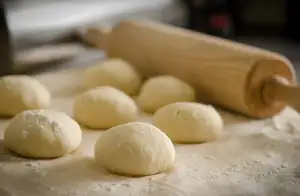Whisking Magic: Master the Art of Making Homemade Butter with Our Step-by-Step Guide

- Gathering the Ingredients and Equipment
- Step-by-Step Instructions for Making Homemade Butter
- Step 1: Pouring the Cream
- Step 2: Churning the Cream
- Step 3: Separating the Butter
- Step 4: Washing and Kneading the Butter
- Step 5: Storing and Enjoying the Homemade Butter
- Tips and Variations for Homemade Butter
There's something truly magical about the process of making homemade butter. The rich, creamy texture and unparalleled flavor are a testament to the artistry that goes into crafting this culinary delight. Whether you're a seasoned chef or a novice in the kitchen, learning how to make your own butter is a rewarding experience that will elevate your cooking to new heights. In this step-by-step guide, we'll take you through the process of creating homemade butter from scratch, allowing you to unlock a world of flavor and creativity in your culinary endeavors. So grab your apron and let's dive into the wonderful world of homemade butter!
Gathering the Ingredients and Equipment
To embark on your homemade butter-making journey, you will need just a few simple ingredients and equipment. First and foremost, you will require heavy cream, preferably of high quality, as it plays a crucial role in the flavor and texture of the final product. Make sure to choose cream that is free from any additives or preservatives.
Next, you will need a mixing bowl or a stand mixer with a whisk attachment. This will make the churning process much easier and more efficient. If you prefer a more traditional approach, you can also use a jar with a tight-fitting lid. Additionally, having a fine-mesh strainer or cheesecloth on hand will be useful for separating the butter from the buttermilk.
Lastly, don't forget about salt! While optional, adding a pinch of salt to your homemade butter can enhance its flavor profile and add depth to your culinary creations. So gather these simple ingredients and equipment, and get ready to whisk some magic into your kitchen!
Step-by-Step Instructions for Making Homemade Butter
Step 1: Pouring the Cream
Start by pouring the heavy cream into a mixing bowl. Make sure the cream is at room temperature for best results.
Step 2: Churning the Cream
Using an electric mixer or a hand whisk, beat the cream on medium-high speed. As you continue to whisk, you will notice the cream thickening and turning into whipped cream.
Step 3: Separating the Butter
Keep whisking until the whipped cream separates into butter and buttermilk. This process usually takes around 10-15 minutes. The butter will start to clump together while the liquid buttermilk separates.
Step 4: Washing and Kneading the Butter
Pour out the buttermilk and rinse the butter under cold water to remove any remaining buttermilk. Knead the butter with your hands or use a wooden spoon to remove excess liquid.
Step 5: Storing and Enjoying the Homemade Butter
Shape your homemade butter into a block or roll it into a log using parchment paper. Store it in an airtight container in the refrigerator for up to two weeks. Spread it on warm bread or use it in your favorite recipes for a delicious homemade touch.
Step 1: Pouring the Cream
To begin the process of making homemade butter, start by pouring fresh cream into a large mixing bowl. Make sure to use high-quality cream, preferably with a high fat content, as this will result in a richer and more flavorful butter. The amount of cream you use will depend on how much butter you want to make, but a pint of cream is a good starting point.
Once you have poured the cream into the bowl, let it sit at room temperature for about 30 minutes. This will allow the cream to slightly thicken and come to room temperature, which will make it easier to churn later on. It's important not to skip this step as it helps ensure that the butter forms properly during the churning process.
While waiting for the cream to come to room temperature, you can take this time to gather any additional ingredients or equipment you may need for making homemade butter. This includes a hand mixer or stand mixer with a whisk attachment, a fine-mesh strainer or cheesecloth for separating the butter from the buttermilk, and a clean jar or container for storing the finished butter.
Once your cream has reached room temperature and you have all your equipment ready, you're now ready to move on to step 2: churning the cream.
Step 2: Churning the Cream
Once you have poured the cream into a jar or mixer, it's time to start churning. This step is where the magic happens and the cream transforms into butter.
If using a jar, tightly secure the lid and begin shaking vigorously. The motion should be continuous and rhythmic. After a few minutes, you will notice the cream thickening and becoming whipped cream.
For those using a mixer, set it to a medium-high speed and let it do the work for you. Keep an eye on the cream as it starts to thicken.
As you continue churning, you will notice a change in texture. The whipped cream will start to separate into clumps of butterfat and buttermilk. This process can take anywhere from 5 to 15 minutes, depending on your method and equipment.
It's important not to over-churn at this stage, as it can result in a grainy texture. Once you see distinct clumps forming, stop churning immediately.
The sound of splashing liquid is an indication that your butter has formed. At this point, you can strain out the buttermilk or save it for future use in baking or cooking.
Churning the cream is an exciting part of making homemade butter as you witness its transformation before your eyes. So enjoy this step and get ready for the next one: separating the butter!
Step 3: Separating the Butter
Once the cream has been churned for a sufficient amount of time, you will start to see the magical transformation take place. The mixture will begin to separate into two distinct components - butter and buttermilk.
To separate the butter from the buttermilk, you can use a strainer or cheesecloth. Carefully pour the contents of the churner through the strainer, allowing the liquid buttermilk to drain out. Gently press down on the butter with a spoon or spatula to remove any excess liquid.
You may notice that the butter is still quite soft at this stage. This is completely normal. The next step will help firm it up and give it that perfect texture we all love.
Remember to save the buttermilk! It can be used in various recipes such as pancakes, biscuits, or even in salad dressings for an extra tangy flavor.
Now that you have separated the butter from the buttermilk, it's time to move on to step 4: washing and kneading the butter.
Step 4: Washing and Kneading the Butter
Once the butter has separated from the buttermilk, it's time to wash and knead it. This step helps remove any remaining buttermilk, which can cause the butter to spoil quickly.
To begin, place the butter in a bowl of ice-cold water. Gently knead the butter with your hands or a wooden spoon to release any trapped liquid. As you knead, you'll notice the water becoming cloudy as the buttermilk is released.
Next, drain the cloudy water and refill the bowl with fresh cold water. Repeat this process until the water remains clear after kneading. This ensures that all traces of buttermilk have been removed.
After washing, transfer the butter onto a clean surface and use your hands to gently knead it. This helps to further remove any excess moisture and create a smooth texture.
If desired, you can add a pinch of salt during this step to enhance the flavor of your homemade butter. Simply sprinkle it over the butter and continue kneading until well incorporated.
Once you're satisfied with the texture and moisture content, shape the butter into a block or roll using plastic wrap or parchment paper. This will make it easier to store and slice later on.
Congratulations! You've successfully washed and kneaded your homemade butter. Now it's time to move on to storing and enjoying this delightful creation.
Step 5: Storing and Enjoying the Homemade Butter
Once you have successfully made your homemade butter, it's time to store it properly and savor its rich flavor. Here are a few tips on how to store and enjoy your creation:
1. Transfer the butter into an airtight container: Use a clean, dry container with a tight-fitting lid to keep your butter fresh. Make sure there is no excess moisture in the container as it can cause spoilage.
2. Refrigerate or freeze the butter: If you plan to use the butter within a week, storing it in the refrigerator is sufficient. However, if you want to extend its shelf life, consider freezing it. Butter can be frozen for up to six months without compromising its taste and texture.
3. Add flavorings if desired: Homemade butter is incredibly versatile, and you can enhance its taste by adding various flavorings such as herbs, spices, or even honey. Experiment with different combinations to create unique flavors that suit your palate.
4. Use it in cooking and baking: Homemade butter adds a delightful richness to any dish. Whether you're sautéing vegetables or baking pastries, using your homemade butter will elevate the flavors of your creations.
5. Spread it on bread or toast: There's nothing quite like slathering freshly made butter onto warm bread or toast. The creamy texture and rich taste will make every bite a heavenly experience.
Remember, homemade butter does not contain any preservatives like store-bought versions, so consume it within a reasonable time frame for optimal freshness. With each batch of homemade butter, you'll discover new ways to enjoy this culinary delight!
Tips and Variations for Homemade Butter
- Experiment with different types of cream, such as heavy cream or whipping cream, to achieve different flavors and textures in your homemade butter.
- Add a pinch of salt to the cream before churning to enhance the flavor of the butter.
- For a unique twist, try adding herbs or spices like garlic, rosemary, or cinnamon to the cream before churning.
- To make flavored butter, mix in ingredients like honey, maple syrup, or citrus zest after separating the butter. This will add a burst of flavor to your spreads and sauces.
- Don't discard the liquid left after separating the butter (known as buttermilk). It can be used in baking or cooking for added richness and flavor.
- Get creative with shaping your homemade butter by using molds or rolling it into logs. This will give your butter an elegant touch when serving it at dinner parties or special occasions.
- Store your homemade butter in an airtight container in the refrigerator. It can last up to two weeks if properly stored.
- Remember to bring your homemade butter to room temperature before using it for spreading on bread or incorporating into recipes for optimal texture and flavor. Enjoy the versatility and satisfaction of creating your own delicious homemade butter!
In conclusion, making homemade butter is a truly magical experience that allows you to create a rich and flavorful ingredient right in your own kitchen. By following our step-by-step guide, you can unlock the secrets of this age-old culinary art and enjoy the satisfaction of creating something truly special.
Homemade butter not only tastes superior to store-bought options, but it also gives you complete control over the ingredients used. You can experiment with different types of cream, add herbs or spices for unique flavors, or even make flavored butters like garlic or honey butter.
Furthermore, making your own butter is a great way to connect with food on a deeper level. It allows you to appreciate the process and effort that goes into creating such a simple yet essential ingredient. The act of churning cream into butter is both therapeutic and rewarding.
So why not give it a try? With just a few basic ingredients and some patience, you can whisk up your very own batch of homemade butter. Whether you spread it on warm bread, use it in baking recipes, or simply savor its creamy goodness on its own, homemade butter will elevate any dish to new heights.
Embrace the delight of homemade butter and let its rich taste and velvety texture transport you to culinary bliss. Once you've experienced the joy of making your own butter, store-bought will never quite compare. So grab your whisk and get ready to embark on this delightful journey – your taste buds will thank you!
Published: 27. 11. 2023
Category: Food



